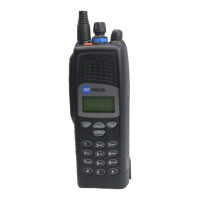TP9100 Service Manual Description 43
© Tait Electronics Limited May 2005
Tx Vocoder FEC
(Digital Mode)
The 88 bits from the vocoder have 56 bits of parity added to them. Different
amounts of protection are afforded to the vocoder parameters, depending on
their relative importance. Four blocks of 12 bits are given highest priority
and are each encoded by (23,12) Golay codes. Three blocks of 11 bits are
afforded less protection and are encoded by (15,11) Hamming codes.
The final 7 bits are unprotected. Finally all 144 bits are interleaved to spread
the affect of bursts errors throughout the frame, and sent to the Burst
Builder.
Tx Signaling FEC
(Digital Mode)
In the same way as voice packets are protected using forward error
correction, so too is the signaling information (control and data).
One example is the network identifier which is protected using a powerful
BCH (Bose-Chandhuri-Hocquenghem) error code.
Tx Burst Builder
(Digital Mode)
It is the nature of a digital radio transmission that the information is
structured into bursts. An air interface burst can take several forms. Every
burst consists of a frame synchronization sequence and Network identifier,
followed by the main body of the burst, the content of which depends upon
the type of burst. For a voice burst, it comprises a fixed number of voice
packets with control signaling and low-speed data interspersed. For a data or
control burst, it comprises a variable number of data blocks. Additionally,
every air interface burst is expanded with a status symbol after every 70 bits
of information. These status symbols are used for channel access procedures.
It is the job of the burst builder to construct the air interface burst using
FEC-encoded code words delivered to it by the signaling FEC and voice
FEC. The burst is then passed to the C4FM modulator.
C4FM Modulator
(Digital Mode)
The burst builder creates a symbol stream that must be modulated onto the
RF carrier. Four possible symbols can be transmitted. They are passed
through a shaping filter defined by the APCO standard which limits the
spectral occupancy on air. The four symbols are transmitted at pre-defined
frequency deviations from the carrier.

